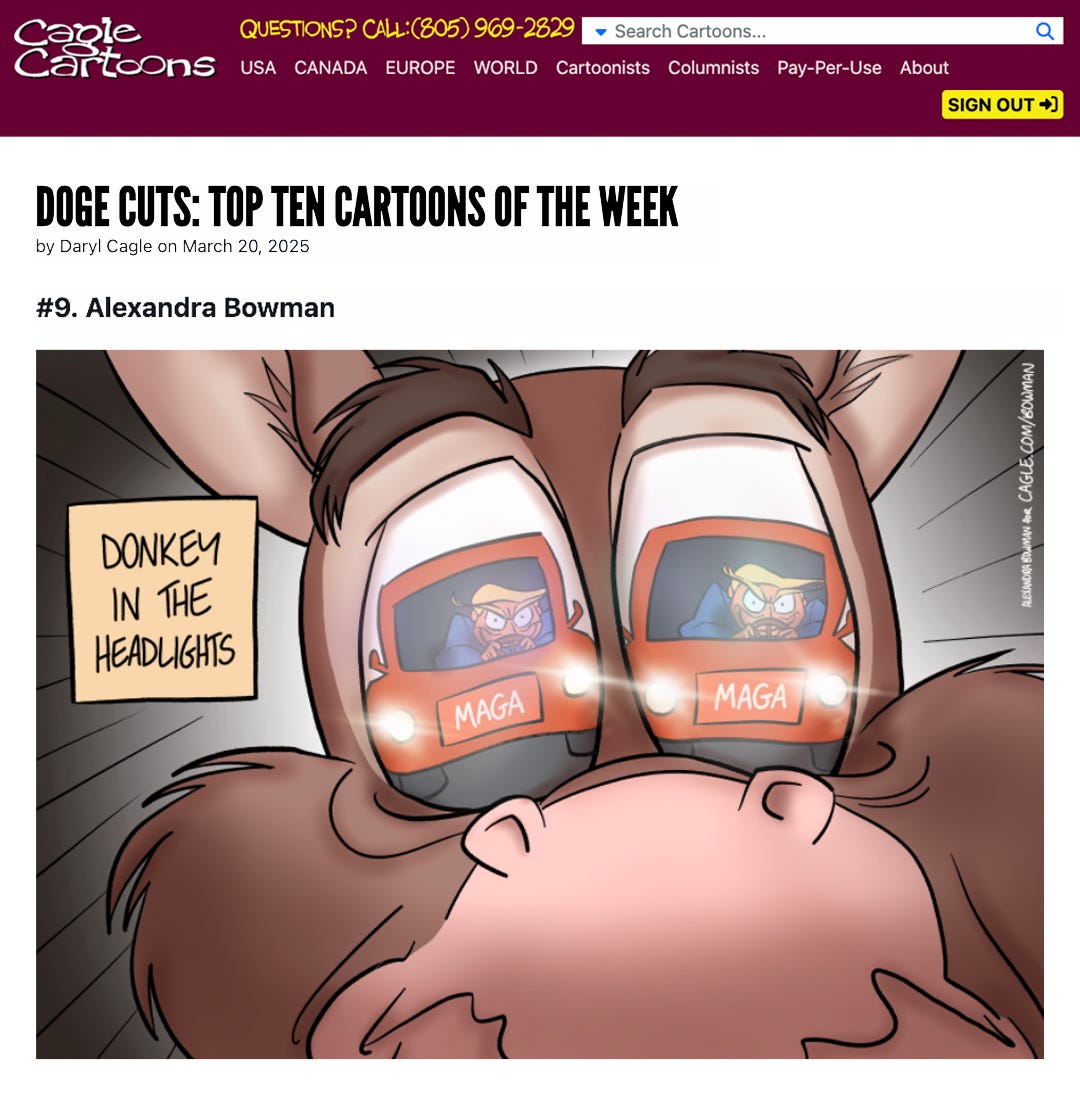Political Cartoon: Democrats at a Standstill
Plus a Cagle announcement, and a discussion of best practices in talking politics in times like these
Hello all! Two things for today. One is a cartoon, the other is an announcement + essay. I’d really appreciate a read.
First of all, here’s my cartoon for Counterpoint/Cagle that went out on March 13th.
It also hit me recently that I’m not sure I ever explicitly mentioned a major recent professional development on my Substack: since this past January, I’ve also been publishing my cartoons through Cagle Cartoons, America’s leading newspaper syndicate for editorial cartoons.
What Cagle syndication essentially means is that I now have access to a platform through which editors of local papers and outlets across the country will have the opportunity to see and select my work for publication. I’m profoundly honored to be given this opportunity.
Towards the goal of maximum reprints, I’ve received encouragement to generally avoid politics, or rather, only discuss politics in a way that wouldn’t raise the eyebrows or negative emotions of a local newspaper reader, but instead either invoke chuckling, pondering, or agreement.
I’ve honestly really struggled with this assignment so far. A major contributing factor is that perhaps optimistically, I feel a sense of heartfelt urgency to talk about politics.
It’s hard to be handed a platform to reach people who I desperately want to talk to and persuade, and then not be able to be direct with them — not even “direct” in the sense of anything close to “lecturing”, but “direct” in the sense of cutting to the chase of a civil, productive argument. I don’t like fearmongering, and I don’t like coming across as patronizing.
Despite what it might look like, I have a profound fear of coming across as self-absorbed, not self-aware, or that I think I know better than people with more age-based or profession-based experience than me.
About four of my freelance employers and mentors are currently putting a valiant effort into beating this mentality out of me. I’ve made some progress but I’m not quite there yet.
Ultimately, I just want to be going about my work in good faith, and hopefully actually make it worth doing.
“Change” on a small, medium, or large scale is one way it would be. Then comes the question: how does “change” happen? Probably not attacking or angering your audience without at least a spoonful of sugar. I get it.
Going about this in good faith, I believe, also means talking about what I believe is a profoundly urgent democratic and cultural crisis. But again, I know that the people who I believe most need to be reached might not listen to me if I frame it that way.
And still, as I’ve been told and agree with, nearly any political talk from a perceived political enemy in a cartoon could shut down the interest of editors and readers at this early point in my career.
And all through this I’ve felt, and will probably feel until I’m about 35, like slapping my own wrist for being too much of an idealistic, change-oriented, Judy Hopps-y young person.
So far I haven’t done the best job at trying, nor trying successfully, to adjust my work to this “avoiding politics” prompt.
But I recently learned that the version of this “donkey in the headlights” cartoon published through Cagle mid-March was the ninth-most downloaded/reprinted cartoon on the Cagle site—which has hundreds of cartoons uploaded per week.
I've found some of the publications that reprinted the cartoon: huge thanks to the Brooklyn Eagle, LA Progressive, West Central Tribune, The Moderate Voice, and The Korea Times. There are more out there...
See the article here on Cagle Cartoons, which I’ve jerryrigged into an Instagram-friendly graphic:
I’m ecstatic about this, especially given the aforementioned challenges.
I also feel that this cartoon doesn’t betray any of my goals as a cartoonist at this period of time. I am relatively certain that one reason this cartoon was so successful is that it depicts a feeling. The Democrat looks both pathetic and sympathetic, and Trump looks both powerful/fearsome and heartless/unkind. People can read whatever they want into the cartoon. Everyone is happy.
As long as I’m doing both “everyone is happy” cartoons and “evidence of my eyes and ears” cartoons, I don’t personally see a problem. I don’t feel myself stretching to believe that or coping, either. I think that’s an okay place to land.
This reminds me of that “50/50” thing I hear from people with tips for creatives posting online. Make 50% of your drawings to please and grow your audience, and make the other 50% to please yourself.
I’m eager to hear your thoughts on these issues, which are at the forefront of a lot of people’s minds at the moment, I think.
Until next time,
-Alex






Just a thought, fellow Cagleite, I am new to the group as well. If I could offer a suggestion it’s to know your audience and temper your opinion accordingly. Sometimes we have to be greeting card artists as Daryl suggests, but we should never surrender or be cowed to use our talent to comfort the afflicted. Satire is needed more than ever today.
I’m glad this cartoon hit the “sweet spot” on the syndication platform—and there’s more where that came from. And I’m sure this one will continue to “have legs” & find new audiences. I like your formula for trusting your instincts and still continuing to create political-themed cartoons/OpEds/late night TV monologues/in whatever media you choose. These times demand the very best hard hitting speak-truth-to-power work you can create. You already have the life experience, the wisdom, and the creative talent to give voice to what so many people are only dreaming they had the courage to speak up about. Big historical moments like these are made for your boldness, & your audience will continue to find you.